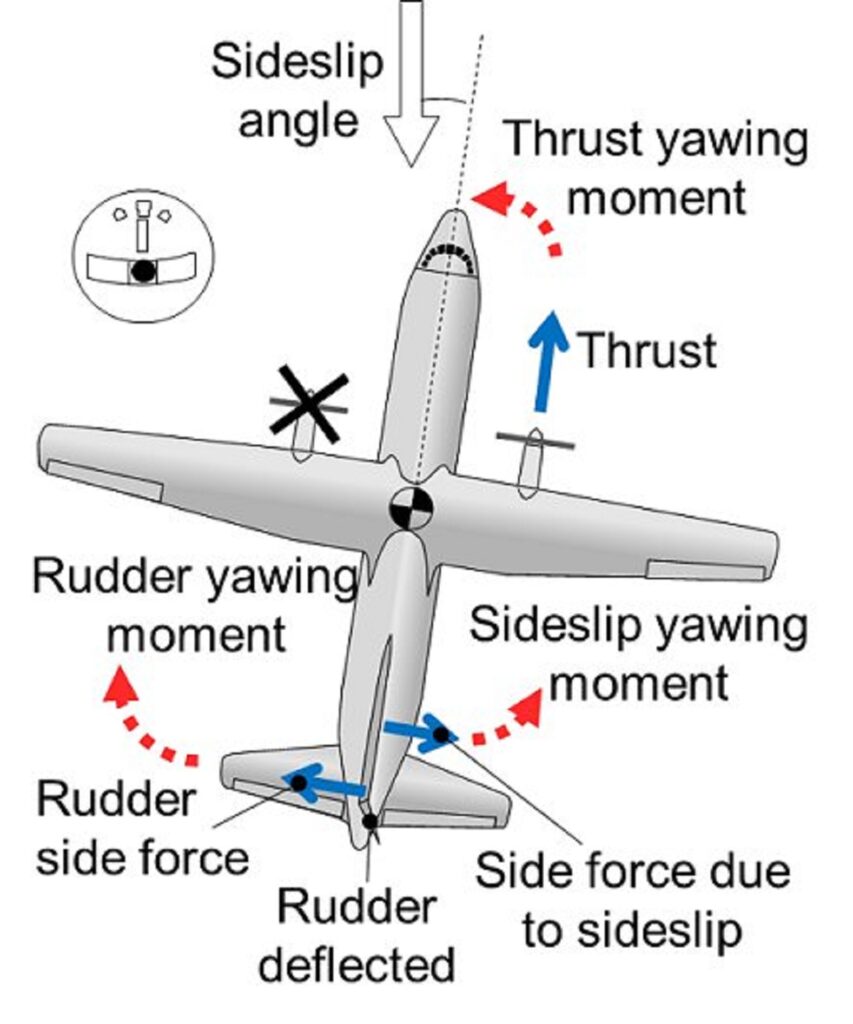The Airbus A320 is equipped with a system called “Alpha Protection” which automatically maintains an optimal minimal drag sideslip angle in the event of an engine failure. This helps to ensure that the aircraft remains in a stable and controllable state, even in the event of an emergency. Additionally, pilots are also trained to manually maintain an optimal minimal drag sideslip angle in case of an engine failure, as a part of their standard procedures.
In normal law, the aircraft flight control computers automatically add in a little bit of rudder to keep the flight path stabilised. But this deflection of rudder is not sufficient enough to fully compensate for the asymmetrical thrust. Thus, when manually flown, the pilot has to step on the rudder and trim it to keep the aircraft from deviating from the intended flight path.
There is however, a nice little feature in Airbus aircraft which directs the pilot to the minimal drag side slip, called the beta target. In any multi engine aircraft, when an engine fails, the pilot has to put in rudder towards the live engine, to counter the undesirable yaw. The problem with this is, it creates a sideslip. If the left engine fails for example, the application of rudder creates a left side slip where the aircraft nose is pointed to the right. This side slip and the resulting air flow hits the vertical stabilizer and the keel surface behind the center of gravity, creating a side force. This side force tries to push the aircraft towards the dead engine requiring more rudder input into the live engine. So, the pilots are taught to put in a small bank into the live engine. This creates a horizontal component of lift which reduces the effects of side slip force. The sideslip also creates drag due to the fact in a sideslip more of the aircraft cross section is exposed into the air flow.
This procedure works fairly well in a small aircraft. But in an aircraft like the A320, the drag produced by the control deflections need to be considered as well. In case of engine failure, the deflection of spoilers and ailerons to get that bank into the live engine creates drag too. This is where the beta target comes in. In an Airbus, when there is an engine failure in critical phases such as in take offs and go arounds, the normal yellow sideslip indicator in the primary flight display changes to blue. The pilot’s job is to get this blue beta target centered like a normal sideslip indicator. When done so, the aircraft will fly with minimum amount of drag on its air frame. The beta target is generated through a complex calculation, based on control surface deflections and the body angle of the aircraft. When beta target is centered, the aircraft is kept at a slight slip, because it is based on a balance between the drag produced by the sideslip and the drag produced by the control surface deflections. The aim is to keep spoilers and ailerons as close as possible to neutral, hence reducing control surface drag. This makes the flight more efficient and improves climb performance in an engine failure.
In the event of an engine failure on the Airbus A320, there are several systems and procedures in place to assist pilots in maintaining control and optimizing the aircraft’s performance. Here are some key points:
- Engine Failure Procedures: When an engine failure occurs, the pilots follow specific procedures provided by the aircraft manufacturer. These procedures include actions to identify and isolate the failed engine, adjust thrust settings on the operating engine, and maintain control of the aircraft.
- Asymmetric Thrust Compensation: The A320 is equipped with an Automatic Thrust Restoration (ATR) system, which helps compensate for the loss of thrust from the failed engine. The ATR system automatically adjusts the thrust level on the operating engine to maintain a balanced thrust and minimize the yawing effect caused by the failed engine.
- Rudder Trim: Pilots may use the rudder trim to maintain a coordinated flight in the presence of asymmetric thrust. By adjusting the rudder trim, they can reduce or eliminate the need for constant rudder input, thereby reducing drag and improving control.
- Flight Control Laws: The A320 has multiple flight control laws that provide different levels of protection and handling characteristics. In normal law, the flight control system automatically adjusts various control surfaces to maintain stability and minimize drag. In the case of an engine failure, the flight control laws may adapt to asymmetrical thrust conditions, helping the pilots maintain control and minimizing the need for manual corrections.
- Alpha Protection: The A320 features Alpha Protection, a system that helps prevent the aircraft from exceeding its maximum angle of attack (AOA) during flight. In the event of an engine failure, Alpha Protection ensures that the aircraft maintains an optimal minimal drag sideslip angle, which helps to reduce drag and improve the aircraft’s performance.
It’s important to note that while these systems and procedures assist pilots in managing an engine failure, it still requires active pilot involvement and appropriate actions to ensure the safe operation of the aircraft. Pilots undergo extensive training to handle such situations and are well-versed in the specific procedures and techniques for managing engine failures on the A320.
By – Anas Maaz
Airline pilot. Airbus A320/A321
By – Aeropeep Team






